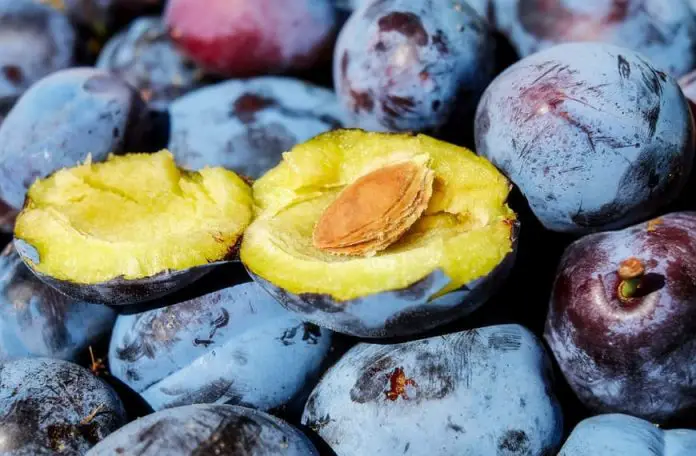Plums can do wonders for us humans. These stone fruits are bursting with protein, iron, potassium, and vitamin C. A study even claimed that plums can kill cancer cells. They are healthy for you, but are plums good for dogs? Let’s see what the experts have to say!
Know Your Fruit: Plums and Can Dogs Eat Plums?
Yes, they can! I confirmed that plums are safe for dogs’ consumption.
Plums fall under the drupe category. A drupe, also known as a stone fruit, is usually characterized by an outer fleshy part that surrounds one shell. In the case of plums, the shell is referred to as the pit. Other types of drupe are peaches and cherries.
Plums are indehiscent fruits, meaning they do not open or split once they reach maturity. This is why you have to use your senses to distinguish a ripe plum. The ripe ones have a deep color, a sweet smell, and feel slightly soft when you touch them.
There are dozens of plum cultivars and varieties. The most common types are the El Dorado, European plums, red plums, Mirabelle plums, and the yellow plums. There is also a hybrid called pluots or plums and apricots. They look like the European plums, but are a bit darker.
In terms of the nutritional value, it is worth knowing that most of the carbohydrates found in plums come from sugar and they contain as much as 90% carbs. The rest are fats, vitamins, and protein. Your puppy can get along just fine without any plums in his diet because, in reality, dogs need more protein than carbs.
The Benefits of Plums for Dogs
On the positive side, canines can benefit from the plum’s Vitamin C content which can boost their immune system. These fruits are very sweet but they don’t really trigger a detrimental spike in your blood sugar levels.
What are the dangers of plums for canines?
Veterinarian Hanie Elfenbein discussed the perils of giving your pooch stone fruit such as plums. Here are the reasons why plums can be harmful to canines:
- The pit could get stuck in the dog’s stomach.
When ingested, the pit goes to your dog’s intestinal tract. The acid in his intestines will break it down before releasing the toxins into his bloodstream.
However, there is a possibility that the pit could get stuck in your puppy’s stomach if he ate it whole. Because our furry friends are normally less discerning about what they ingest, gastrointestinal obstruction is fairly common to them. Still, obstruction is a serious issue that calls for surgery. A foreign object obstruction is often characterized by abdominal pain and vomiting. Your puppy may also have a change in appetite.
- The cyanide in the pit can poison your dog.
The pit is the main reason why many pet experts do not recommend giving plums to canines. The covering of the pits contains amygdalin, a chemical compound that breaks down into hydrogen cyanide when consumed.
Hydrogen cyanide is poisonous. This chemical compound is the reason why plum pits have the “bitter almond” smell. The cyanide only comes out when the kernels of the pit are broken. The good news is that this rarely happens.
Remember that the hydrogen cyanide cannot only be found in the pit but also in the stem, roots, and leaves of the plum tree.
If you have a plum tree in your backyard, keep an eye on your dog whenever he goes close to it in order to make sure he doesn’t eat the fruit that falls off from the tree.
Plum trees are generally small and most dogs could easily reach the lower branches. The easy fix is either trimming some branches or installing a fence around the tree. Your last option, of course, is to cut down the tree for the safety of your dog.
- It may have molds that can cause digestive problems.
Did you know that even a fresh plum could have a moldy pit? Ingesting a moldy pit can lead to gastrointestinal upset. The worst thing to happen to your pooch is developing a liver failure because of molds.
When throwing away the plum pits, make sure they are not within your dog’s reach. Proper disposal is important especially if your puppy likes digging in your trash can. If you can’t train your puppy to stop raiding the trash, better keep those plum pits in a secure place.
- The pits may break your dog’s teeth.
A plum’s pit is very solid and it is harder than an almond seed. If the dog ate the whole fruit, including the pit, he could break his teeth by biting into it.
Gnawing solid objects may injure his molar or large premolar teeth. For mild fractures, your vet may recommend crowns and additional dental works. If the damage is very bad, your dog needs to undergo surgery and even extraction. To avoid your little friend fracturing his teeth, make sure he does not have access to hard objects, including stone fruit pits.
- The pits can impair his esophagus.
A dog’s esophagus has a sensitive lining that can be destroyed by physical injury. Some plum pits have sharp edges that can damage your dog’s esophagus.
The symptoms of esophagitis in dogs are regurgitation, difficulty when swallowing, and too much saliva dripping from his mouth. Your dog will likely be asymptomatic when the esophagitis is mild. Thus, his vet will not recommend any treatment.
- When rotten, the plums can intoxicate your pooch.
I am sure you would not give any rotten fruit to your dog. But if your pet was accidentally exposed to a rotten plum and ate it, this could also post a potential danger. Fruits normally ferment when they are rotten. Once it reached the fermentation stage, the sugar in the plums could turn into alcohol that can intoxicate them.
Plums go through a “brown rot,” a fungal disease common in drupes. Yes, it is possible for plums to rot on the tree, with the Victoria varieties being the most affected ones.
The fruits can get rotten right even before you pick them. This fungal disease among stone fruits happens when there is a sudden increase of moisture in the area. If you have a plum tree, inspect it daily and get rid of the rotten fruit before any animal gets to them.
What Are the Symptoms of Plum Poisoning in Dogs?
The good news is it will take a lot of pits to worry about cyanide poisoning. If your dog ingested a pit or two, there is no reason to panic, especially if the dog did not show anything to be concerned about. Nonetheless, it would not hurt to educate yourself about the warning signs so here they are:
- muscle spasms
- tight jaws
- difficulty in breathing
- lack of energy or enthusiasm
- runny stool
- changes in stool color (usually green and dark red that looks like blood)
- seizures
- heavy panthing
- bright red or pink gums
Seek medical attention when you noticed these warning signs along with behavioural changes in your dog. Your vet will conduct a series of exams to determine the real cause of these symptoms.
In most cases, vets can easily tell it is plum poisoning if the gums look bright red. Sometimes, they may be pink and this is due to highly oxygenated blood. Presuming that it is cyanide poisoning, your vet will likely induce vomiting or give the dog an anesthetic to flush the stomach.
What To Do When Your Dog Already Ate Plums?
In case your dog accidentally ingested the whole pit, do not induce vomiting at home. Don’t do it unless you received a green light from your vet or poison control centre. Hydrogen Peroxide is the most preferred dog emetic. A teaspoon of 3% hydrogen peroxide is the recommended dosage for a dog weighing 10 pounds.
If you are not confident about getting your dog to vomit, let an expert do it. Forcing the pit back up could obstruct his airway. It is best to consult your veterinarian before taking any action.
Presuming you think induced vomiting is the most appropriate solution, better have it done by your vet. Your doctor will just give your pet an injection to keep him safe.
In case the dog has a runny stool, offer him bland foods that can help firm his stool. The most common choices for dogs with diarrhea are chicken and white rice. Give this meal to him for a few days until the situation is remedied.
He may also need a food rich in dietary fiber to ease his digestive tract. Consider a pure pumpkin or yogurt. If he can tolerate dairy, you may also offer cottage cheese. As long as the pit did not cause any blockage or obstruction and it is small, your dog should be fine.
Conclusion
Plums are a safe occasional treat for canines. They are not as toxic as grapes or raisins that can harm your dog even in small quantities.
With the right preparation, you can have peace of mind that your puppy is safe from any potential hazards. As long as you only offer the flesh, there is nothing to worry about giving plums to your dog. Cut the flesh and give it as it is or put it on top of your dog’s kibbles. A good rule of thumb is never let your pet eat the pit.





















